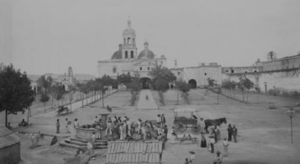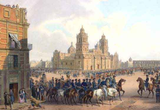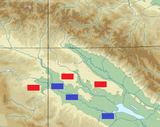Anahuacano Civil War

|
This article or section is a work in progress. The information below may be incomplete, outdated, or subject to change. |
| Guerra civil Anahuacana | |||||||
|---|---|---|---|---|---|---|---|
 The historic center of Guerrero, the capital city of Granaditas State, viewed one month before the city became the scene of the final battle of the Anahuaco civil war. |
|||||||
|
|||||||
| Belligerents | |||||||
| Republicanos | |||||||
| Commanders and leaders | |||||||
| -José Joaquín of Anahuaco -Emiliano Orozco | -Roberto Sanchez -Ignacio Sanchèz Herado |
||||||
| Strength | |||||||
| -7,000 regulars -25,000 volunteers -40 artillery pieces | -4,000 regulars -42,000 volunteers |
||||||
| Casualties and losses | |||||||
| -820 killed -6,500 wounded | -3,500 killed -10,400 wounded |
||||||
The Anahuacano Civil War (Martino: Guerra civil Anahuacana) was an internal armed conflict fought in Anahuaco between June 1704 and February 1705. Nominally triggered by the filing of incorrect customs paperwork, the war was the manifestation of a variety of ethnic and historic grievances. Ultimately, the conflict came to be about the form of government Anahuaco would adopt as a new nation.
Background
Prior to the establishment of Anahuaco as a modern state, the territory of what is now the empire underwent various stages of human settlement. The oldest recorded inhabitants of the area, unoriginally known simply as Las Originales, played almost no part in the civil war, although they were accused of subversive activities by both sides and subject to arbitrary detention and other forms of punishment.
The origins of Las Originales is unclear, but it is speculated that the group is an amalgamation of individuals from Nova England, Gran Verionia, the Warring Islands and Xang Muang who formed a unified and distinct culture over several generations while living in The Green.
La Gran Migración
The era of the Grand Migration laid the seeds for the conflict to come. Starting in 1680, the first wave of migration came from the territories formerly occupied by Gran Verionia, with Martino-speaking migrants arriving and settling the fertile coastal territories of what would later become Anahuaco. This first wave consisted of migrants carried the republican instincts and politics of Gran Verionia with them, and set about establishing a loose form of government based on these principles.
This early form of state-building was led by Ignacio Sanchèz Herado, a hero of the Verionian community who was largely credited with leading his community into their new territory. While Las Originales were not happy with the incursion into their historic lands, the two groups had limited interaction and lived in largely peaceful isolation from each other.
Nova English collapse
The second wave of migrants arrived around 15 years after the first, following the final demise of Nova England to the north of the territory. The inflow reached its peak in 1697. This group also brought elements of their culture with them from their former homeland, with Nova England having been both a monarchy and broadly militaristic.
Despite these differences, the Nova English migrants mingled freely with the migrants from the first wave of the Grand Migration and the two groups became increasingly integrated and indistinguishable. The language differences which initially existed between the Martino and Britannic Istvanistani speaking communities largely disappeared, with Martino becoming the de facto language of the territory, while Britannic Istvanistani retained its dominance of international trade and commerce.
Intercommunity tensions
Despite these early signs of community cohesion, tensions began to arise as the fledgling government authorities began to assert themselves more actively in everyday life, notably with the imposition of taxes and customs levies on trade. The latter in particular caused tension, with migrants of Nova English descent bearing the brunt of the impact due to their predominance in international trade.
Intercommunity violence on a low level began in the year 1700, with bar fights and other petty arguments quickly escalating into street battles using primitive weapons such as clubs, knives, and petrol bombs.
Discontent amongst the Istvanistani-speaking* population led to the creation of community government, running in parallel to the existing authorities created by the Martino-speaking* community.
- The terms Martino and Istanistani are used here for the sake of simplicity. In reality, a large degree of intermingling had occurred, and both communities usually spoke Martiono and were almost indistinguishable from one another.
Ciudad Grande Declaration
Proclaimed in November 1703, the Ciudad Grande Declaration was an accord between Las Originales, the Martino-speaking community, and some elements of the Istvanistani-speaking population. The declaration asserted four key points:
- There would be one central government to consolidate control over the territories where the groups lived.
- The new government would establish control over a defined area, roughly encompassing the modern-day territory of Anahuaco.
- The government would have the right to raise taxes, levies, and military forces to ensure security.
- The capital of the new territory would be the largest settlement within it- the newly named Ciudad Grande.
The declaration was the result of increasing concern amongst the Martino community regarding the shadow administrations being set up by elements of the Istvanistani community. The unspoken goal of the declaration was to create a government that could claim to be legitimate and representative, and therefore bring the rogue elements of the nation into alignment.
While the Originales community was largely unaffected by what was happening, their leaders were convinced to sign as an indication of their continued good faith towards the Martino community, with whom they had longstanding good relations.
Build-up to war
There are broadly three events that are considered to have made war inevitable.
Divided political sentiment
While the Ciudad Grande Declaration was signed by some elements of the Isvanistani community, the majority refused to sign. The declaration was considered, with some factual basis, to be an attempt by the Martino community to enforce their preferred system of government. Amongst the migrants from Nova England and their descendants, pro-monarchy sentiment remained strong and they considered the Ciudad Grande republican government to be a culturally alien imposition.
Even amongst the Istvanistani elements who did sign the declaration, enthusiasm for its goals was minimal, and many community leaders indicated that they signed to gain commercial advantages rather than because they actually agreed.
Ill-conceived military recruitment
When the government at Ciudad Grande established military forces to enforce their territorial claims, the majority of new recruits came from the Istvanistani-speaking community. Similarly, the new officer corps was manned almost exclusively by experienced officers from the Nova English Army.
While the government welcomed this as a sign of loyalty from members of the community, the opposite was in fact true. Many recruits joined up either purely on the basis of their enjoyment of military life, or because they wanted to be in a position to protect their own community from the government itself.
In essence, the government used tax revenue to train and arm forces who were at best lukewarm towards the state, and at worst actively aiming to destroy it.
Resentment over Customs fees
The government of Ciudad Grande believed that the growing merchant class was gaining its wealth by stripping the natural resources of the territory, with international exports blamed for deforestation and environmental pollution from illegal mining. In an attempt to stem the outward flow of the territory's natural resource wealth, the government introduced an export tax of 50% of declared value.
While the government's claims were objectively accurate, the imposition of the tax was seen as a direct attack on the merchant class. As a result, many merchants began secretly importing weapons to protect their commercial interests. Skirmishes between government customs officers and traders broke out in spring 1704, and quickly escalated.
In a particularly infamous incident at Puerto Domínguez in May of that year, 4 customs officers were murdered by a gang of intoxicated traders, following the impounding of goods due to be exported with falsified paperwork.
The shots that killed the customs officers in this altercation, known as the Constantine Incident (named after the impounded ship involved), are generally considered to be the first shots of the civil war.
First Phase
Following the Constantine Incident, events moved very quickly, with poor communication over long distances making centralized coordination extremely difficult. While in the immediate aftermath of the killings very little happened, around 1 week later messages started reaching Ciudad Grande regarding attacks on customs officials at other ports. This quickly expanded inland, with government offices and customs houses being attacked and burnt.
As events unfolded, the government in Ciudad Grande called up all regular armed forces at their disposal. The response was erratic and inconsistent, with some units assembling quickly while others stalled. While this inaction was blamed on communication problems, in reality the officers of the new army had no intention of fighting for the government.
March of the garrison
During the opening days of the first phase, Puerto Domínguez was the heart of the rebellion. For that reason, the government in Ciudad Grande dispatched the capital's garrison to the south on June 15th. The government authorities were unaware that, as the garrison of 5000 regulars left the city, a group of around 2000 armed rebels was already less than 36 hours away. Crucially, the Garrison's commander (Pedro de la Peña) received permission to take the city's 40 artillery pieces with them on the march.
It is speculated that de la Peña was aware of the approaching rebels and encouraged the government to dispatch them to the south to leave the city undefended. While this is speculation, it is certain that the garrison's commanders chose a route south that very deliberately avoided coming into contact with the rebels approaching in the opposite direction.
Ciudad Grande surrounded
Hereafter, events moved very quickly. On June 16th 1704 word began to reach Ciudad Grande from all directions of bands of armed men approaching. The government immediately send out messengers ordering de la Peña to return, and calling on reinforcements from elsewhere in the country. These messages went unanswered and, by the evening of the same day, it became obvious that the city was surrounded with very little hope of relief.
Surrender
On the morning of June 17th, a message arrived from the leader of the rebels, the same Roberto Sanchez, demanding the surrender of the city, under the threat of an infantry assault. With no forces at their disposal, and with the hope of avoiding civilian casualties, Ciudad Grande surrendered without a fight at 14.00 that same day.
Aftermath
Although the grievances leading to the first phase of the war were considered sectarian by some, the rebels who captured Ciudad Grande were not entirely from one community or another. The government, in its short period in power, had been considered heavy-handed and accused of imposing an unfair tax burden on the community while offering little in return.
The customs grievances impacted the Istvanistani-speaking community the most, but this group did not exist in isolation, and they received a large degree of sympathy from the wider community within the territory.
Following the capture of Ciudad Grande, the rebels proclaimed a nation, and called a constitutional convention with the aim of fostering the broad, inter-community support that the Ciudad Grande government had failed to achieve early on. During this first phase of the war, the death toll is believed to have been in the low hundreds.
Constitutional Convention
Following the overthrow of the Ciudad Grande government and the declaration of a new nation, a Constitutional Convention was convened with the aim of creating an inclusive new form of government that would satisfy the wishes of the new nation's various communities.
Almost immediately however, a clear division emerged between those who wanted to retain the republican principles of Ciudad Grande, and those who wished to see a monarchy established. The latter group consisted primarily of migrants from Nova England and their descendants, but not exclusively, with both camps enjoying a degree of support from each community.
During this period, Pedro de la Peña and the former garrison of Ciudad Grande reached Puerto Domínguez and declared their intention to remain there to ensure public order during the period of transition.
Dialogue and deadlock
Initially elated at how easily they had seized power, the scale of the differences within the rebel groups quickly became apparent. The element led by Roberto Sanchez favored a reconfiguration of the model used by the Ciudad Grande government, but with clearly defined institutions, free elections and separation between the executive, legislative and judiciary branches of government.
Meanwhile the opposing faction, led by Emiliano Orozco, favored a more dramatic change, claiming that the Ciudad Grande system was inherently oppressive and should be dismantled in its entirety. This faction favored a parliamentary monarchy styled after Nova England and New Britannia, with a monarchy that retains significant personal powers.
While the two factions agreed on many of the broad social goals and specific policies they'd like to see implemented, the division over the style of government continued to fester and intensify.
People's assemblies
As part of the Constitutional Convention process, People's assemblies were convened, with the aim of hearing the specific issues and desired outcomes from the convention. These gatherings began in August 1704 and were widely considered to be a success, with various policy ideas taking shape. However, as summer progressed and autumn began, the issue of the type of government began to dominate the discussions at the assemblies, with both sides encouraging their supporters to attend with the intention of dominating the discussion.
This call for support led to a large influx of civilians into Ciudad Grande, including a considerable number of new arrivals from the former territories of Nova England. These émigrés, fresh from living a volatile life in The Green tended to be both armed and heavily in favor of Orozco's monarchist cause.
Escalation
By Christmas 1704, the two sides of the debate had adopted the names that they continue to be known by- Republicanos and Imperialistas. While heated debates at the Constitutional Convention intensified, scuffles and street fights between the supporters of the two sides began within the city, and a steady stream of new arrivals from The Green continued.
On December 31st 1704, word reached Roberto Sanchez that Pedro de la Peña and his men had departed from Puerto Domínguez and were heading back towards the city with the aim of breaking the impasse by force. Rightly suspecting that de la Peña had Imperialista sympathies, Sanchez and his supporters fled Ciudad Grande on the morning of New Year's Day 1705.
Second Phase
The second, bloodier phase of the civil war began with the flight of Roberto Sanchez and the Republicanos from Ciudad Grande on January 1st 1705.
Declaration of a Republic
Sanchez and his supporters fled to the settlement of Guerrero, in what is now Granaditas State. They believed that the isolation of the settlement, coupled with the harsh desert terrain, would buy them time to organize an armed force to take Ciudad Grande and convince de la Peña's men to join them.
While Sanchez was initially reluctant to do anything dramatic, many of his supporters believed that he needed to make a grand gesture in order to draw attention to his cause and rally support. At the encouragement of his supporters, on January 3rd 1705 Sanchez declared a Republic in the name of the name given to the area by Las Originales: Anahuaco. The Republican tricolor flag was raised over Guerrero, and a steady trickle of support began to arrive from both the surrounding state the territory more broadly.
Declaration of an Empire
While initially taken off guard by the sudden flight of Sanchez and the Republicanos, the Imperialista faction broadly welcomed their departure, with the hope that their opponents would now vanish into obscurity.
When word reached Ciudad Grande that Sanchez had instead declared a republic and called for insurrection against them, the Imperialistas reacted swiftly. Within 48 hours of Sanchez's declaration, two things happened: Pedro de la Peña's force arrived in Ciudad Grande, and Emiliano Orozco proclaimed the Anahuacano Empire from the balcony of the government administration building.
In attempt to show themselves as the one and only legitimate government, and heirs to the government formerly based in Ciudad Grande, the Imperalistas declared Sanchez to be an outlaw. After a brief show trial, Sachez and his supporters were found guilty of treason in absentia, and de la Peña was dispatched to Guerrero to apprehend the felons. While this was presented as a routine policing operation, it was very obviously anything but that.
Battle of Granja Poreco
As war got underway, both sides aimed to assemble as many men to their cause as possible, with the Republicano side in particularly playing for time to allow their forces to assemble. While the majority of the former army of Ciudad Grande had fallen in behind Pedro de la Peña, some elements had joined the Republicano cause, along with a sizeable detachment of volunteers.
To buy time to fortify their positions and arm their new recruits, the Repulicano's aimed to ambush the force dispatched by the Imperialistas before it had time to reach its full strength.
Pedro de la Peña left Ciudad Grande on January 8th and, within 3 days, his column reached the border with the state of Granaditas. At this point, the main road followed a natural valley between two small ranges of hills at a settlement named Granja Poreco.

